|
Monday, December 20, 2010
Progress Notes
The colder temperatures of the last week herald the end of fall and the beginning of winter once again. One of the memories from the past I most have associated with this time of year is hunting. My grandfather, Madison Bear (photo 01), first introduced me to hunting when I would accompany him in the woods behind his home on Highway 17 not far from the junction with County Road C.
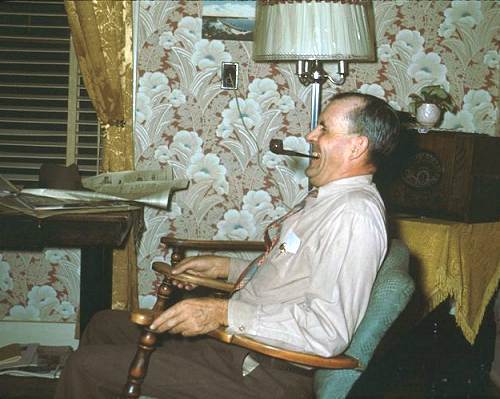
01 Madison Bear He had a single shot .410 and was pretty good with it usually bagging a squirrel or rabbit for supper that evening. My uncles Ansel and Fred Pryor (photo 02) used to enjoy quail hunting. Ansel had an English Setter and Fred had English Pointers.
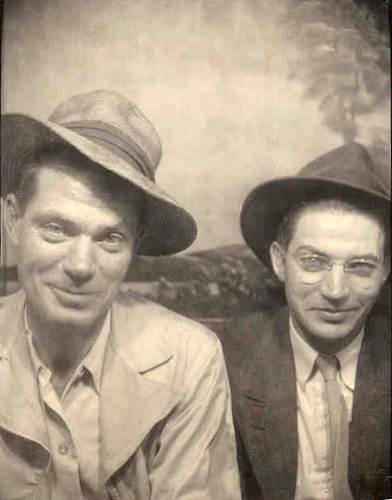
02 Ansel and Fred Pryor Back in the 1950’s we still had some decent habitat for quail since farmers had not adopted the practice of clearing off the underbrush from property boundaries as much as they do now. Also, lespedeza grass was abundant then which is better for quail habitat than the fescue almost all the pastures have these days. I remember there was even a resident covey of quail within the limits of Tuscumbia along Highway 52 not far from where is located our museum building today.
We still have some quail to hunt in Miller County where the cover is adequate and food supply available. Mike Steen of Iberia, cousin of my wife Judy, usually has several good quail hunts here in the fall with his friend, Dr. Robert Mason of Lake Ozark.
Mike, whose family owns the Iberia Lumber Yard, gave a significant donation in the name of the business to help with our expenses for the Bridge Opening Ceremony earlier this year (photo 03).
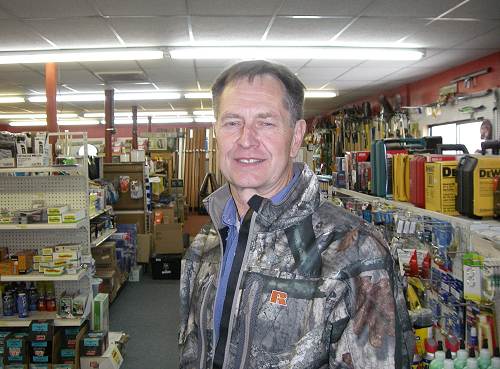
03 Mike Steen Trapping also was done quite a lot during the 1920’s and 1930’s and before then to harvest fur for the markets in St. Louis. My Aunt Barsey Abbett Curry’s husband, Irving, was a trapper (photo 04).
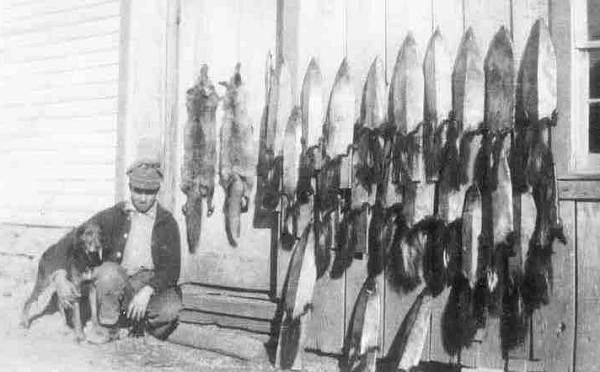
04 Irving Curry - Husband of Barsey (Abbett) Curry He managed the MFA store in St. Elizabeth for many years. He and Barsey lived on Humphrey Creek not far from Capps.
Later when I lived in the Kansas City area I kept my own bird dogs and hunted quail and pheasants in Kansas and western Missouri. I also traveled once a year to Minnesota to hunt woodcock and ruffed grouse. I’ve collated here some of my hunting photos (photos 05 - 13).
Hold your mouse cursor over a photo to read the caption and click on any of the thumbnails to view a larger image.
Note: Once you click on an image below, a new window will open. It would be best to maximize this new window by clicking on the middle box in the upper right-hand corner of the window. When you move your cursor over the image in this new window, it will change to a magnifying glass. Once this occurs, click on the image and it will show in a larger format for easier viewing.
I was saddened recently to learn of the death of Michael McIntosh, well-known author of books having to do with shotguns and bird hunting (photo 14).
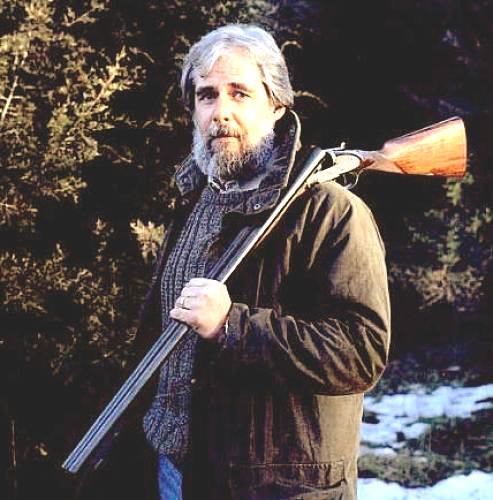
14 Michael McIntosh Michael was born in Iowa but spent many years in Missouri, first as a college English teacher and later as a writer for the Missouri Conservationist magazine. Here is his obituary (photo 15).
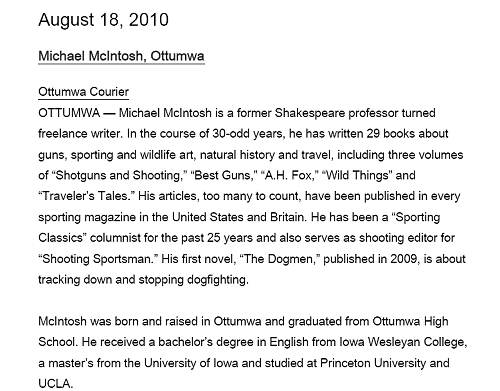
15 Michael McIntosh Obituary
Click image to read entire obituary in PDF formatI became acquainted with Michael in 1990 when he lived near Jefferson City. He had just written one of his most popular books entitled Best Guns where he discusses the world’s best made shotguns (photo 16); I wanted to visit with him to inquire as to whether he would give me guidance in making the right choice of the purchase of an English made double barrel shotgun.
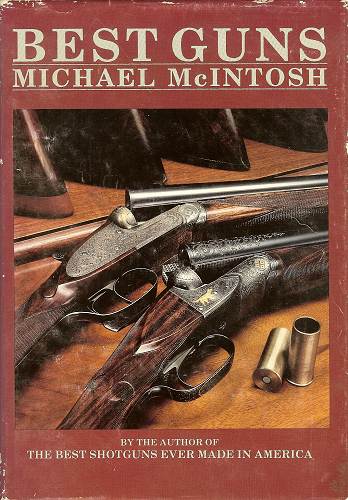
16 "Best Guns" Cover Michael was an expert of the subject of shotguns, American as well as British and European made. It was his opinion and that of many other gun historians that the London craftsmen of the late 1800’s who made the double barrel shotgun had been the most skilled of all the early gun makers. Our trip to London, England to visit some of the old gun shops and gun makers was one of my most memorable. One of his acquaintances who lived south of London and who was the most experienced in the subject of the English made shotgun was Jack Mitchell. Jack also was a shooting instructor (photo 17).
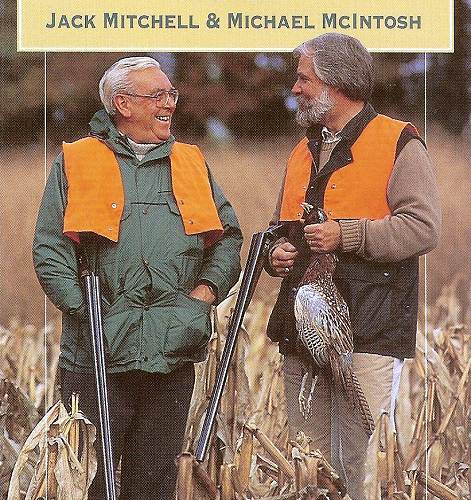
17 Jack Mitchell and Michael McIntosh He knew of an old Purdey 12 gauge shotgun (made in the late 1880’s) which was old enough that I might be able to afford it. No way I was going to be able to buy a new one, that was for sure! Jack gave me some shooting lessons while we were visiting him (photo 18).
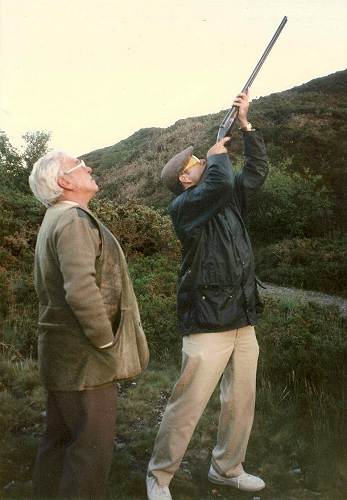
18 Jack Mitchell and Joe Pryor in Southern England After that trip Michael and I hunted together quite a few times both in this country as well as in Europe where what is known as driven shooting was very common (photos 19 and 20).
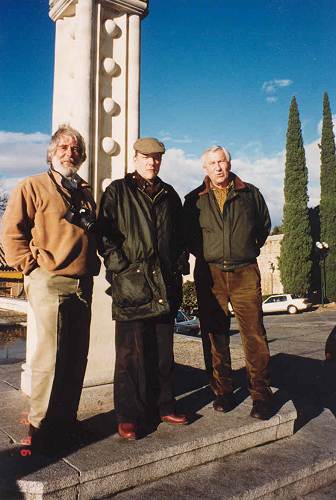
19 Michael McIntosh, Joe Pryor and Jack Jansma in Spain
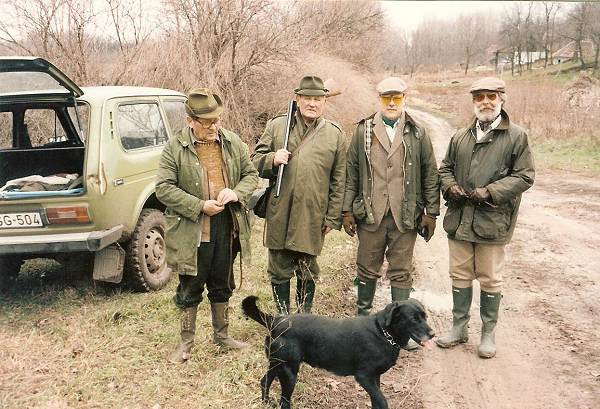
20 Joe Pryor and Michael McIntosh in Hungary Quite often through the years I would consult Michael regarding one or more questions having to do with guns. For example, in one of my previous Progress Notes I quoted Michael’s response to a letter I sent him asking him to identify in a photo the different guns being displayed by a group of men in the Faith community of Miller County. You can read that discussion at the Progress Notes of September 2, 2007.
I know that any discussion of shooting in Europe has little to do with Miller County. In fact, about the only thing the rest of the narrative this week has to do with Miller County is that Miller County is where I was raised! Except maybe for one thing; Judy’s heritage is Scottish through her grandmother McDaniel’s side of the family so the next subject which is about shooting in Scotland will have to do with the country of origin of some of her ancestors.
The sport of “driven shooting,” is commonly enjoyed in Europe and the British Isles. The prey usually are pheasants or partridge. However, in Scotland the highlands are home to a very sporting bird known as the “red grouse” (photo 21).
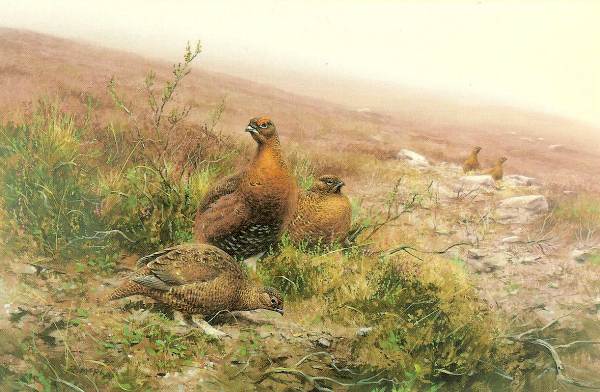
21 "Spring Grouse" by Roger McPhail This bird flies low to the ground very fast, sometimes reaching sixty miles per hour if it has wind behind it. Many shooters who have tried it will remark that the red grouse provides the most challenging of all wing shooting. The harvested birds are gathered by neighboring land owners who use the opportunity to train their dogs for retrieving (photo 22).
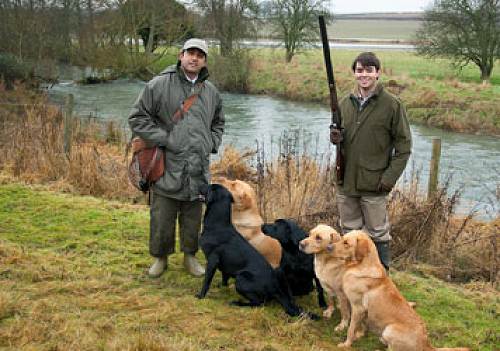
22 Neighbors with their Dogs The retrieved grouse are quickly cooled and sold to a game dealer who markets the birds to restaurants in Scotland and England where wild red grouse is considered a delicacy.
I had the opportunity in 1991 to participate in a driven grouse shoot on the Glenlivet estate near Tomintoul, Banffshire. My partner on the trip was Charles Edwards of Great Bend, Kansas. Here is a photo of Charles I took one day on another trip when he and I were having lunch after hunting with Michael McIntosh (photo 23):
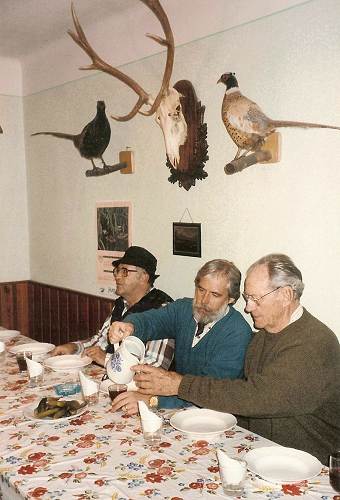
23 Chuck Edwards and Michael McIntosh I described the trip in detail in a narrative I wrote soon afterward. I will place that narrative here and then at the end of it place a collage of photos which include scenes from that trip as well as others I made to Scotland in the 1990’s.
Driven Grouse in Scotland 1991
Chuck Edwards and I left Kansas City Saturday, August 17, after a delay of one day due to mechanical problems with American Airlines the day before, which caused us to miss our original flight for Glasgow out of Chicago. However, we spent the next morning, Saturday, shooting skeet, and I got to witness son John shoot a fifteen…only his second time shooting skeet. The flight was uneventful to Glasgow, and after Chuck drove us out of the metropolitan area (he had been here before), I took over the driving so I could learn how to drive on the left. The first problem to encounter was the roundabout, where four roads meet at concentric circles, where one tries to merge with the traffic and exit at the desired location to continue the journey. If you miss the exit, you have to continue around the circle and try again. The second challenge is to get used to the steering wheel on the right, which causes one to drive uncomfortably close to the left side of the road because of the fear of colliding with an oncoming car in the opposite lane on the right. I had trouble with running off the road at times, and Chuck said I was close to removing some mirrors on parked cars. Finally, one has to face progressive narrowing of the roads as one travels farther into the highlands of Scotland, such that, at times, the roads truly are one lane, with wide spots so that two cars can pass each other. In the highlands, the roads are narrow and curvy, with steep hills, and almost nonexistent shoulders. Also, the natives drive very fast, too fast I think (and I am used to this type of terrain, having been raised in the Ozarks), so I found that I was leading lines of traffic behind us several times, making me nervous. Next time I will rent a smaller car, so that I won’t be so intimidated by the narrow roads. Also, it helps if one has had a good rest before driving north out of Glasgow (which we hadn’t as we left town immediately after arriving from our all night flight).
We arrived at Tomintoul, Banffshire about four thirty, and drove to the Kynadrochit Lodge, a short distance away from this small town, in about ten minutes (photo 24).
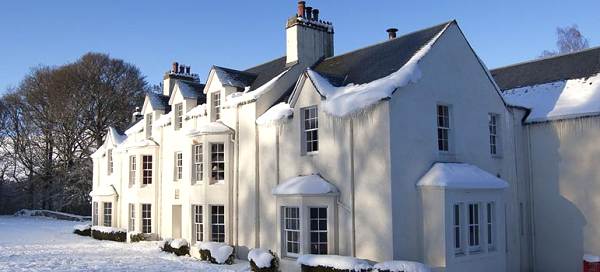
24 Kindrochet Lodge The lodge was built as a private residence in the early 1900’s, for a minister’s daughter, but in recent years was converted to a lodge for sporting guests on the fifty thousand acre Glinlivet estate. The estate is managed for the Crown by Tom van Holten, who is originally from Belgium, and he greeted us at tea soon after we arrived. His sister, Sophia, is the hostess of the lodge, and both of them attended breakfast and dinner every day.
Monday morning we left the lodge after a breakfast of bacon, eggs, fruit, cereal, orange juice, and coffee, and rode to the moors in a caravan of Land Rovers (photo 25).
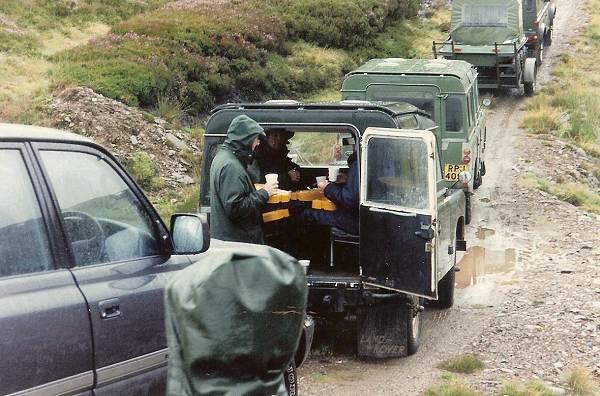
25 Range Rover Caravan The shooting party consisted of Merwin Ray and his son Brad, Kent Campbell, Tom Karea, Chuck and myself; and two additional shooters which changed from day to day. Merwin and Brad owned a steel finishing company; Kent was an executive with LTV Corporation, and Tom was a stockbroker. These four were friends and came as a group. The two add ons each day were continentals, or locals, friends of Tom’s.
The morning was overcast and rain spit at us in a light mist most of the day. This helped the shooters, though, because the grouse couldn’t see us as well and didn’t tend to flare as they sped over and by us at frightening speed. As usual, the wind was up, and the grouse shot through like bullets at us, trying to escape the twenty five or so beaters (those who drive the grouse toward the shooters) and flankers behind (photo 26).
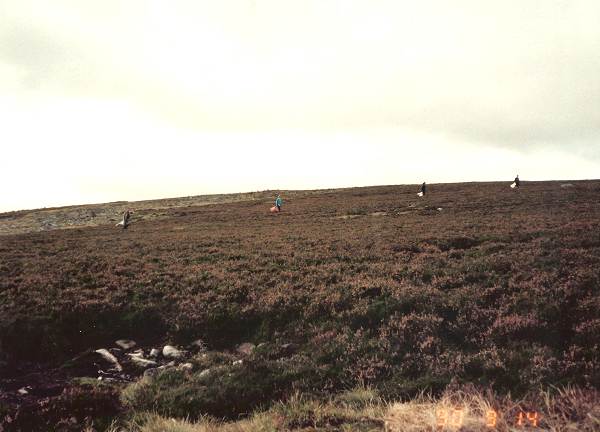
26 Beaters in Scottish Moor - Aug. 1990 They came in packs of five to ten, sometimes in two’s and three’s (photos 27 and 28).
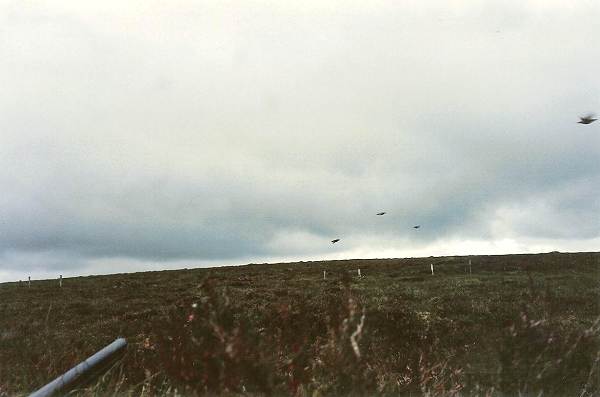
27 Here come the first ones...
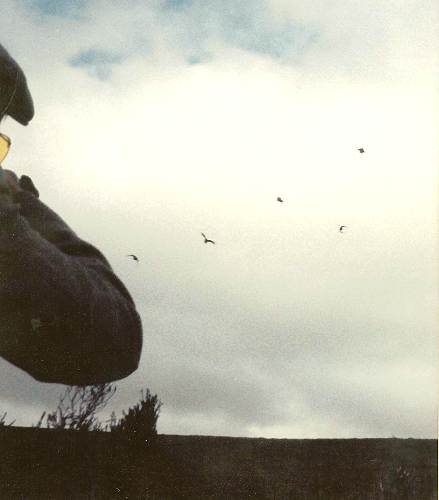
28 Here they are! I missed my first two tries, as I was nervous and getting used to shooting my recently acquired Purdey shotgun at game, after a year’s layoff. I had practiced with it on clays, but nothing in clays can simulate the grouse. However, because of the mist, and the camouflage it afforded, I began to get some easier shots, and bagged four brace on the first drive. On the third drive, I got my first “double” of the week, both birds coming toward me and to the right of the butt, so that I swung through the rear bird, and after connecting with it, continued through the second lead bird and dropped it also. A double in the British Isles is called a “right and left,” since traditionally, the shooting here has been with side by side double barrel shotguns with double triggers.
Lunch was in a small hut, which sheltered us from the rain. Tom built a fire which felt good. Our chef was a gourmet cook, the one who prepared our meals at the lodge, and the food for the lunches usually consisted of a hot soup, sandwiches and meat filled pastries. Dessert was always provided, usually a fruitcake, fresh fruits, or a candy of some kind. Drinks included wine, water, beer and carbonated beverages.
In the afternoon, visibility was better, and one could see the grouse further away as they first approached the horizon. At first they appeared as little gnats on the skyline, bumping up and down, as they would land half a mile away. One couldn’t see them continuously as they approached because of the uneven terrain on the moors, and because grouse always fly very low to the ground, following the contour of the ground at very high speed, sometimes exceeding eighty miles an hour, I am told. They are very difficult to shoot at times, not only because of their flying habits, but also because the butts are usually located just below a rise in the ground, to better hide the shooters from the wary oncoming grouse. The end of it all is that many times they appear all at once in front of you in a pack, and one has no time to collect thoughts or make plans…just mount and shoot and load as quickly as possible to try to get off another two rounds behind as they fly past. One has to try very hard to pick one bird to shoot, rather than “brown” as it is called; that is, shooting at the pack with no bird in particular in focus. Most of the time this causes one to miss everything even though they seem so close together. Sometimes, especially if they are flying against the wind, and are younger birds, they are close enough that the shot pattern may bring down two at once. But this is considered poor sportsmanship by the traditional grouse shooter, and displeases the game keeper as well. This is because, for game management and reproductive reasons, he would prefer that the older grouse, which fly stronger and faster and are less likely to be “browned,” be shot, since they tend to be less reproductive as they age.
We are always told to take our first grouse way out in front, at about sixty yards. If we don’t, and if we wait for the grouse to get closer for an easier shot, many times we wait too long, and end up contorting ourselves backward as it flies overhead. Or else we swing through the line of guns in butts to our sides, a very definite violation of protocol, due to the danger to other shooters of our shot striking them as we shoot at these low flying birds. The trouble is, the novice shooter almost always misjudges how fast these birds are traveling, and he ends up waiting too long to take his shot, even at what he considers an ideal range. By attempting to take the shot at sixty yards, by the time the finger obeys the brain, the grouse already is at forty yards, which is a killing range. Then, one has an opportunity to fire a shot at a second grouse in front, which may be directly overhead by that time. Then one can turn around, reloading as he does, and take two shots behind.
Theoretically, one could down four grouse from a pack this way, but that’s never happened for me, and it appears exceedingly difficult to me to accomplish when one has to first, be an expert shot, which I am not, and second, reload fast enough to get off two reasonable shots behind. Grouse shooters in the past, and on some shoots today, use two matched guns, and a loader, who hands them the freshly reloaded second gun for the shots behind. But this takes a lot of skill and practice to perform well on the part of loader and shooter, and if these requisite abilities aren’t present, can present a sometimes dangerous situation…to say nothing about the risk of banging around some oftentimes very expensive firearms. I have had trouble making myself take the grouse way out in front, and am never sure whether to shoot a little high, or a little low, because it is difficult to always be sure of the angle of flight relative to me or the terrain. Tom van Holten says the most common error at those distances is failure to recognize that the bird is not coming directly at you, but just a little to your left or right, such that a straight on shot, without allowing for some lead to either side, is the usual cause of misses. Churchill in his book on game shooting says to “shoot their legs out” when considering elevation. I suppose this is because game guns are made to shoot a little high.
We had four drives this first day, two on each line of butts. A butt is a hole in ground lined with stone to hide the shooters from the incoming grouse. Here is a photo of Chuck in a butt (photo 29):
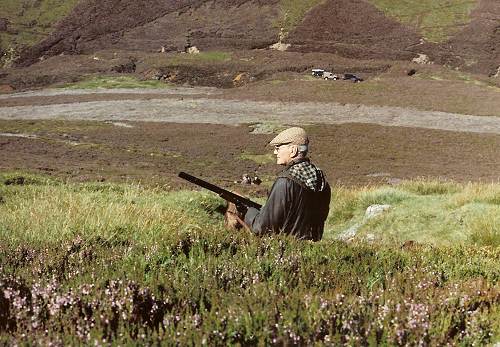
29 Chuck Edwards in Butt After the first drive, we would move up two butts, turn around, and wait about thirty minutes for the next drive to begin from the opposite direction. The beaters, usually high school students from the community, would be transported about two miles away, and then make their way toward us in a long semi-circle, walking evenly and steadily, to ensure the grouse stayed in front and didn’t fly behind or to the sides. The moors are full of heather which is difficult to walk through, and the hills are steep and long, such that by the end of the day, the beaters have well earned their pay of ten pounds. The flankers are off to the side and some distance ahead of the butts, and their task is to wave white flags at the grouse to scare them back toward the butts, if they try to escape out the sides. The beaters have white flags too, these days made of plastic, which create a very distinctive flapping noise as they are held up into the wind.
In addition to beaters and flankers, the estate team includes the “pickers up” who with their very well trained dogs, spot the downed grouse behind the lines, and after the shooting stops, let their dogs find and retrieve them (photo 30).
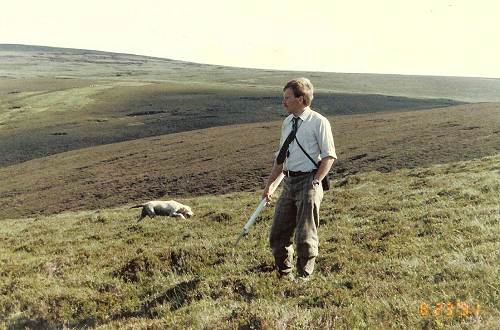
30 Picker Upper with Dog The pickers up are placed well behind the line of guns, perhaps one hundred yards, at least far enough to not scare the oncoming packs of grouse out the sides before passing over the line (sometimes “gun” refers to the shooter and not the firearm). These gentlemen with their dogs often are neighboring estate owners, who appreciate the opportunity to work their dogs on live game as training. Some of the pickers ups are professional trainers who also are happy to have some live bird training for their dogs. These dogs are usually Springer Spaniels or Labrador Retrievers, and if it weren’t for them, many of the downed grouse would be lost in the heather.
About every drive produces a few wounded birds which run after being downed, but the dogs get right on them and retrieve them. Occasionally, a bird can be wounded, but not show any sign of it at the time of shot penetration, such that the gun doesn’t realize he has connected; but after rocketing past the gun, and out of sight, the grouse drops to the ground short of where the others are flying, indicating it indeed has been wounded. The pickers ups with their dogs, though, are there to mark the downed bird and retrieve it.
The beaters gradually make their way forward until they are clearly visible to the line of guns, at which point at about fifty yards away they stop. For a few moments, they hold this position hoping to spook any birds hiding in the heather between them and the guns such that the birds get up in the air and hopefully fly toward the line so that the guns can have a few more shots at the stragglers. After a while, the gamekeeper blows a loud horn signaling that no more shots are to be taken in front. From then on, the gun is to face behind himself, so that any bird which gets up in front has to fly past the gun before a shot can be taken, clearly in a direction opposite that of the beaters. Then the beaters move forward again, and as they approach the butts, when it becomes clear no more birds are going to get up into the air, the gun begins to sleeve his weapon, and mark his downed birds for the pickers ups who will be coming shortly from behind to retrieve the birds around or near each butt. I always point a spent shell in the direction of a downed grouse so I can remember where the bird fell. In this way I can help the men with the dogs find the birds, and save them time and trouble.
The grouse are collected at the end of the day, and put in the estate’s game larder or room, where they are hung to await the arrival of the game dealer (photo 33).
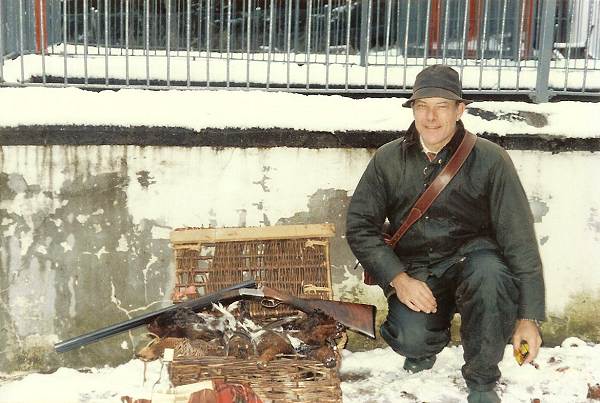
33 Grouse in the Bag I am told that on “The Glorious Twelfth,” the opening day each September of grouse shooting season, that grouse are flown from the moors to some of England’s finest hotels and restaurants for preparation for their customers, who are eager to partake of this fine and expensive delicacy.
At the end of the day, we had downed sixty one brace (122) of grouse, and I had accounted for ten and one half braces. Tom van Holten always shot as a ninth gun, and being an excellent shot, I imagine he would have gotten fifteen of those brace.
After shooting, we returned to the lodge and enjoyed tea with pastries, usually the richest desserts of the day. Dinner was served promptly at eight that and each evening, and consisted of four or five courses, all of which were superbly prepared (photo 34).
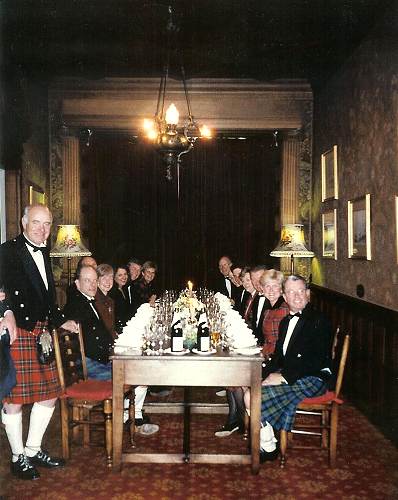
34 Dinner After dinner we would retire into the parlor for coffee, very strong, and a mint. A full selection of wines and liquors were available, as well as beer for the after dinner drinker (photo 35).
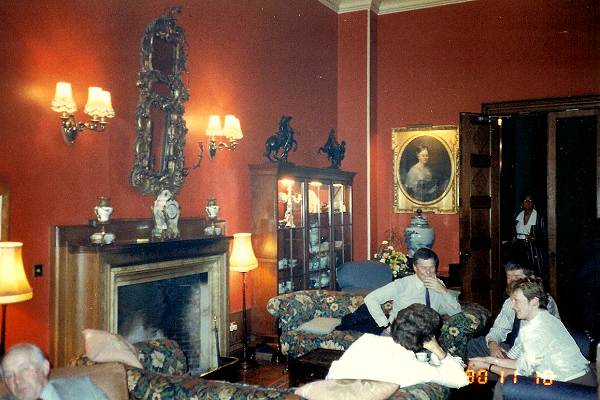
35 After Dinner Conversation My room was private, and included a private bath, which I appreciated. The service was excellent at the lodge with clean linens daily, and a superior house staff which maintained the rooms and lodge in a very neat condition.
Tuesday was partly cloudy, and consisted of five drives for a total bag of forty six brace.
Wednesday was a no shooting day, so Chuck and I traveled north to Cronarty to shoot sporting clays at the Dan Fraser Shooting Ground. This course had five stations, and was neatly laid out in a picturesque setting near the Cronarty Firth, an island body of water. George Digweed had shot a fifty there, we were told, but I could manage only a thirty five or so.
Thursday, we were fogged out, such that the beaters couldn’t see each other well enough to maintain a good line, and the shoot was considered incomplete, although we still bagged twenty eight brace for the day. We should get a partial refund since we were told we had insurance for such possibilities.
Friday, we had a good day and bagged a total of fifty-one brace. My total for the week of shooting was thirty brace even. I shot two days with my Purdey, and two with my Citori. It didn’t seem to make much difference over all, and I would rather shoot my Purdey when in the British Isles, thinking to myself that as old as it is (1885), no telling how many times it had been there before, perhaps on or near this same estate, maybe in the hands of some distinguished Lord or Earl! Amazing that it seems to be tight and shoot straight after all those years.
Saturday morning, after all the appropriate goodbyes and after settling our bill, Chuck and I left Kynadrochit and headed toward Glasgow with me driving. I didn’t seem to have any trouble driving on the left, and we made our connections home easily, arriving in Kansas City about nine thirty in the evening (5:30 a.m. in Scotland). Many good memories were captured and recorded on pictures and notes, which I have recapitulated here.
Here is a collage of photos arranged in no particular order taken during the above described trip as well as others I took to Scotland during the 1990’s (photos 36 - 51g).
Hold your mouse cursor over a photo to read the caption and click on any of the thumbnails to view a larger image.
Note: Once you click on an image below, a new window will open. It would be best to maximize this new window by clicking on the middle box in the upper right-hand corner of the window. When you move your cursor over the image in this new window, it will change to a magnifying glass. Once this occurs, click on the image and it will show in a larger format for easier viewing.
You can read more about the Red Grouse of Scotland at this website.
I have been acquainted with Bill and Betty Roark of Olean for several years now since I joined the MHSC for the reason that they are one of the best resources about the Olean area (photo 52).
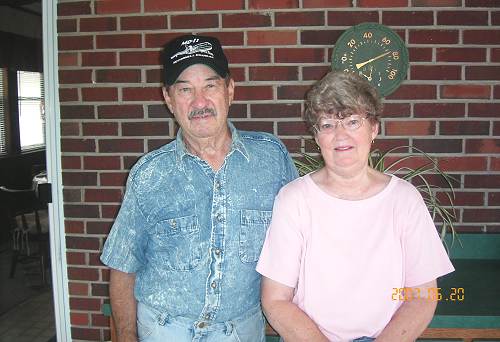
52 Bill and Betty Roark Betty has saved many photos and newspaper items from the past which I have copied for our website. Just last week she helped us research the history of the Olean Switchboard which we now have on display in our museum, thanks to Kevin Malear, who donated it to the museum. It certainly helped that it was her grandfather, William Bartsch, who was the first Olean Switchboard operator. You can read more about the switchboard at the Progress Notes of last week.
Bill Roark’s mother, Sidney W. “Bobbie” Johnsey, who originally was from the Kaiser area, passed away just last December 5, at the age of 96 (photo 53).
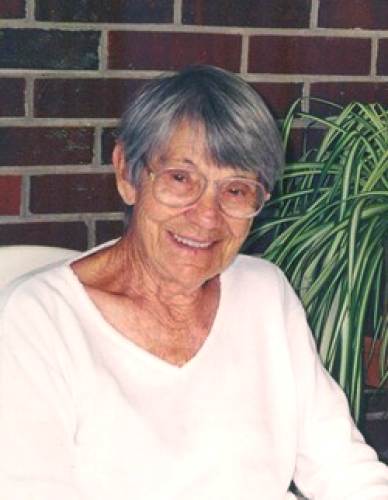
53 Sidney W. “Bobbie” Johnsey Her parents were Sidney Worth & Melinda (Snellen) Cardwell. One of the interesting photos we have, which was donated to the museum by Bill and Betty, shows Bill’s grandfather, Sidney, running an old time steam powered threshing machine (photo 54).
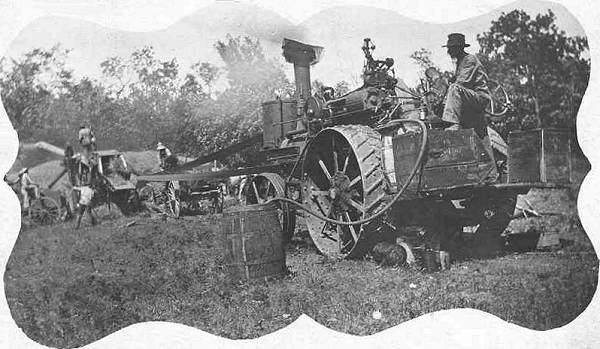
54 Sid Cardwell threshing at Kaiser - Grandfather of Bill Roark The families of both Bill and Betty have deep roots in Miller County.
Here is Mrs. Johnsey’s obituary:
Sidney W. “Bobbie” Johnsey
Sidney W. “Bobbie” Johnsey, 96, of Eldon, Missouri passed away Sunday morning December 5, 2010
at Eldon Healthcare in Eldon, Misouri. On April 1, 1914 she was born near Kaiser, Missouri to the late Sidney Worth & Melinda (Snellen) Cardwell.
Surviving her: Son & Daughter in law, Billy G. & Betty Roark of Olean, Missouri; Daughter, & Son in law, Grace M & Richard Goodman of Jefferson City, Missouri; Step Daughter, Sandra G. Johnsey of Chandler, Arizona; Granddaughter & Grandson in law, Cindy R. & Steve Sweeten of Lohman, Missouri; Grandson, John K. Goodman of Fairway, Kansas; Great Granddaughter & Husband, Hannah R. & Stacy Hammann of St. Mary, Georgia; Great Granddaughter & Husband, Amanda K. & Scott Hammann of Russellville, Missouri; Great Grandson & Wife, John & Beth Sweeten of Lohman, Missouri; Four great great Grandchildren: Kamryn Sweeten, Zane Sweeten, Katie Grace Hammann & Aaron Hammann; Sister, Wilma Hazelbaker of Des Moines, Iowa; and several nieces & nephews.
She was married on April 3, 1931 to Eulis Burnett “Bert” Roark, who preceded her in death on March 16, 1961, and then married William F. Johnsey on September 10, 1965, who preceded her in death on March 1, 1989. She is also preceded in death by five sisters, Velma Smith, Sofa Phelps, Ofa Fischer, Susie Dietrich & Nellie Brummet and by two brothers, Cleet Cardwell & Earl Cardwell.
Visitation was held on Wednesday December 8, 2010 from 9:30 - 10:30 AM at Phillips Funeral Home of Eldon, Missouri with the Funeral Service beginning at 10:30 AM with the Bro. Ryan Stiffler officiating. Interment followed at the Riverview Cemetery in Jefferson City, Missouri.
Memorials are suggested to Hospice Compasses 600 Monroe St. Suite 100 Jefferson City, Missouri 65101.
Last week I was joined by Ellis and Jackie Bray (photo 55) for a long walk to the site of a circle of large stones I was shown recently by Roy Sone when he took me on a guided tour of the J.R. Wells farm near Tuscumbia.
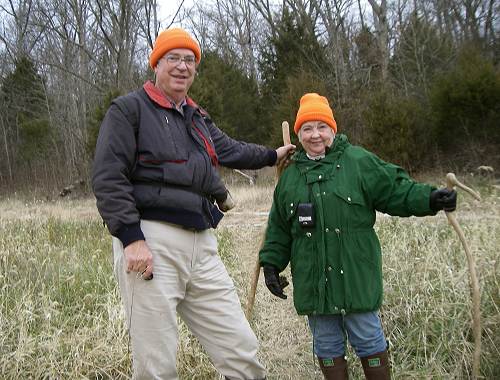
55 Ellis and Jackie Bray You can read about that very interesting outing at this previous Progress Notes.
Ellis and Jackie have an interest in the history of the Native Americans in our area as well as rock and mineral collecting. After about twenty minutes we located the circle of stones, which is found on the highest point of the main ridge of the Wells farm which parallels Highway 17 west of the Saline Creek (photo 56).
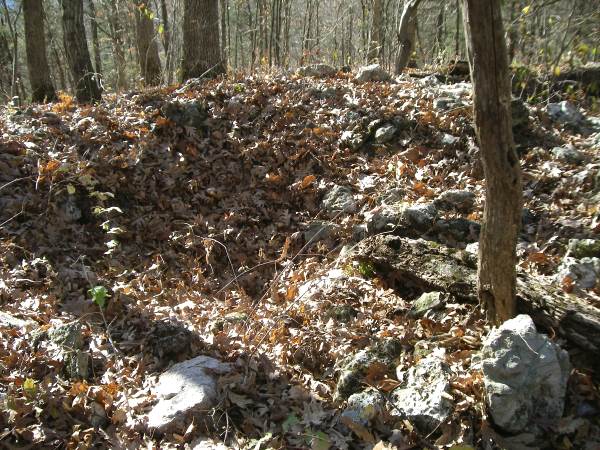
56 Rock Circle Ellis, who is in charge of our Native American display at the museum, told me he believed the circle of stones was an old Indian burial. The name given to these types of burials is “Cairn.” As I mentioned in the Progress Notes for the week of November 22, I had discussed by phone with Ellis previously the layout of the rocks and their position on the highest hill in the area and he at that time suspected it was a Cairn. Now by on site inspection of the site he has confirmed that the rock circle indeed in his opinion was an old Cairn. What was even more amazing that day was that while Ellis and I were looking over the Cairn, Jackie discovered another, smaller one nearby and slightly down the hill. It was hard to see being covered by leaves and brush; I am amazed she found it!
Cairns are not that numerous in the area and this Cairn is the first one I have ever seen. You can read more about Cairns at this website.
Janet Hix Buthold paints Christmas season paintings each year for the cards she sends to friends and family. Here is the one she sent this for this year (photo 57):
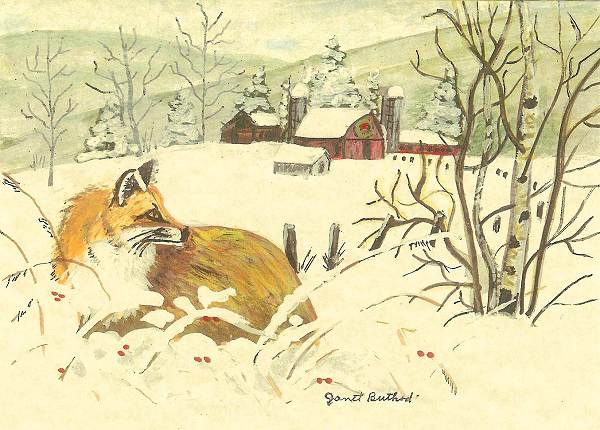
57 "Winter" by Janet Hix Buthold The scene is from her own farm where she and Marvin live north of Eldon a few miles west of Highway 54. Janet says the fox has his eye on the chicken house to the side of the barn.
Here is a photo of Janet wearing a raccoon stole and hand warmer just the way her mother, Ida Hauenstein Hix wore it (photo 58).
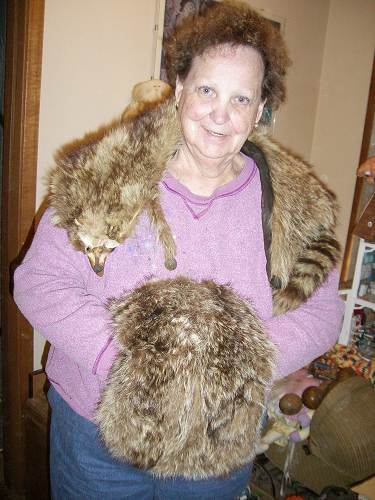
58 Janet Hix Buthold with Raccoon Stole and Hand Warmer that belonged to her mother Ida Hauenstein Hix The house in which Janet was raised in Tuscumbia is located across and down the street a short distance from the Christian church. It was built by Janet’s father, Byron Hix in the early 1930’s. The home recently was purchased by Carl McDonald, one of our museum board members, who with the help of another board member, Jim Clark, is remodeling the home. Carl plans to leave his home in Jefferson City and move to the renovated home. Here are some recent photos of the home (photos 59 and 60):
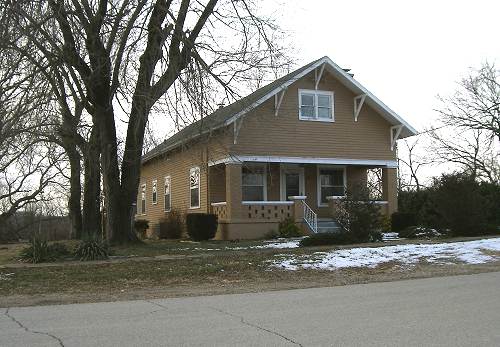
59 Hix Home
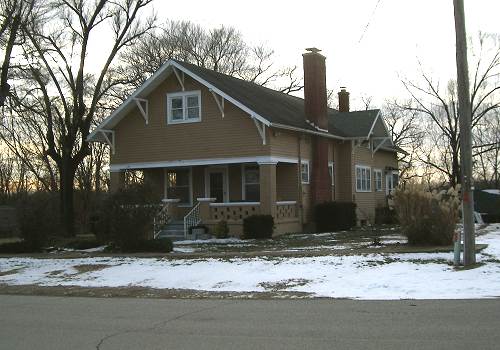
60 Hix Home Just across the street is the C.B. Wright home (photo 61).
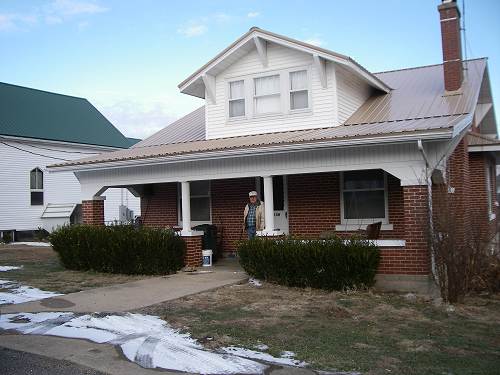
61 Clarence Wright Home C.B. was one of the last president’s of the Anchor Mill Company in Tuscumbia. He also was one of the old time steamboat captains who knew the Osage River very well. This historic home also was built in the 1930’s. Standing in the doorway on the porch is present owner, John Pendleton (photo 62):
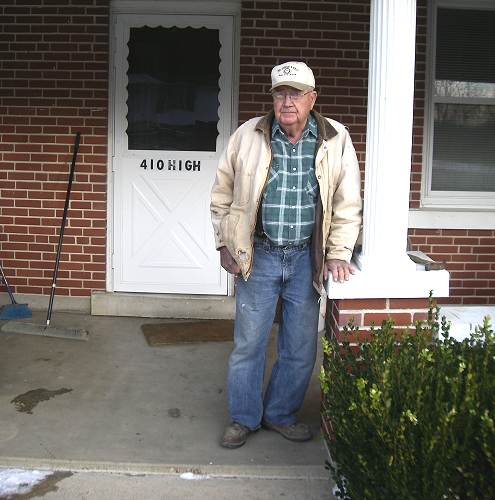
62 John Pendleton - Present Owner He is the father of Pam Pendleton Jarrett, wife of Don Jarrett, whose historic farm and family was featured on the Progress Notes of November 29, 2010.
Before signing off for this week I leave you with some Christmas decorations my mother in law, Elva Steen, placed in her home, beginning with the crèche which depicts the birth of Jesus Christ, the reason for the year’s most important holiday (photos 63 - 66).
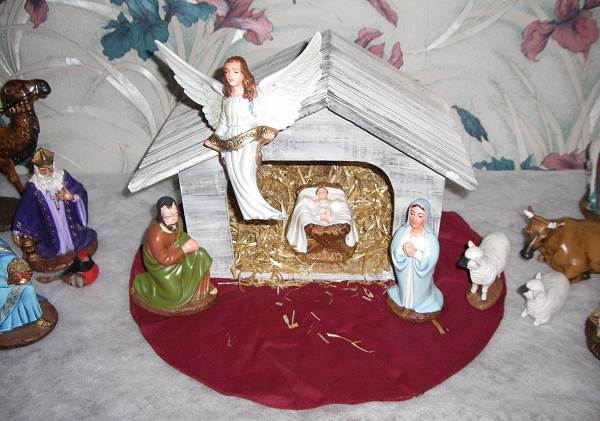
63 Crèche
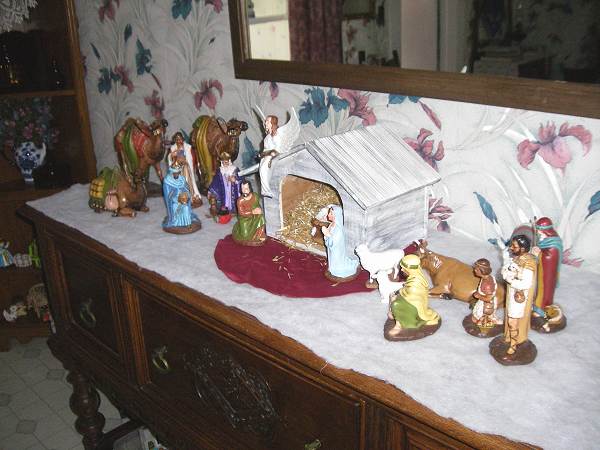
64 Crèche
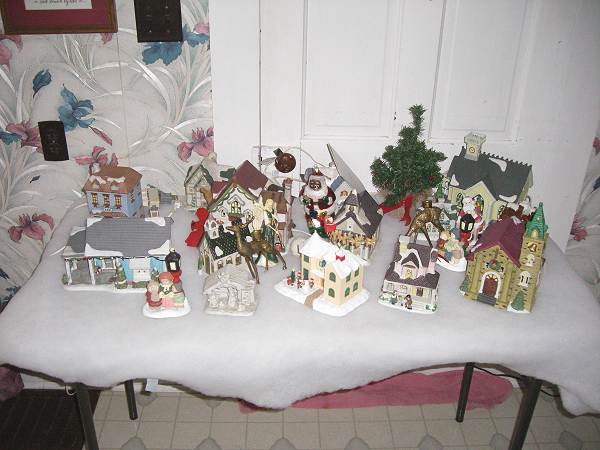
65 Christmas Village
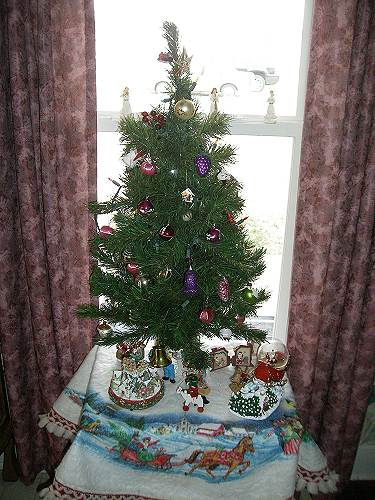
66 Christmas Tree
That’s all for this week. Merry Christmas!
 Joe Pryor
Previous article links are in a dropdown menu at the top of all of the pages.
|

